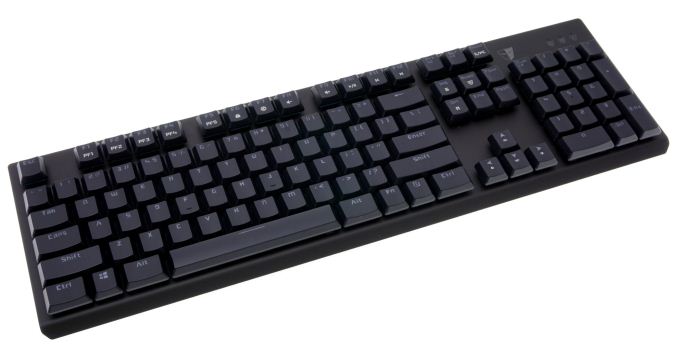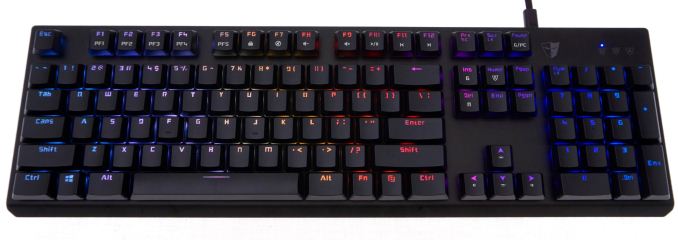The Tesoro Gram Spectrum Low Profile Mechanical Keyboard Review
by E. Fylladitakis on August 22, 2016 8:00 AM EST- Posted in
- Mechanical Keyboards
- Peripherals
- Keyboard
- Tesoro
- RGB
Conclusion
I always try to use every keyboard that we review as my personal keyboard for at least a week. My typical weekly usage includes a lot of typing (about 100-150 pages), a few hours of gaming and some casual usage, such as internet browsing and messaging. As I am used to switches with a 4 mm key travel, I am usually worried with any type of switch that alters the travel distance, but I rarely actually encounter any significant problems. The Agile switches of the Tesoro Spectrum Gram were, unfortunately, an exception. The high action force and strong tactile feedback in combination with the shortened key travel were alien to what I have been used to up to this date, and it took several days for me to get used to typing without bottoming down every keystroke. It did not feel very comfortable even after I got used to it, as the shortened key travel is not ideal for long typing sessions. In combination with the relatively high operating force of the switches, the Gram Spectrum increased my fatigue levels significantly.
The primary purpose of this keyboard however is not typing, but gaming. The Gram Spectrum did feel practical and comfortable for long gaming sessions. The shortened height of the keyboard counteracts the lack of a wrist rest and the keyboard did not stress my wrists even after hours of gaming. Tesoro’s Agile switches are a little stiff but provide good audible feedback, which some gamers will appreciate but others will discard it in favor of lower noise solutions. The programmability of the keyboard was relatively limited, but I did program a fairly effective gaming profile, adjusting the layout of a few keys and having others launch macro commands compiled with an external application.
As for the shorter actuation distance, Tesoro’s Agile switch is virtually no different than any other “gaming” switch that we have encountered to this date. The shorter actuation distance does technically reduce the time required for actuation, but the difference is just a few milliseconds at best. With tactile, heavy switches such as these, there is virtually no pragmatic advantage over the standard counterpart of the switch.
Wrapping things up, Tesoro baptized the Gram Spectrum with a showy name but the actual product is based on a very subtle, minimalistic design. The combination of a flat, plain metallic top and low profile keys can mislead even experienced users into believing that this is a typical office keyboard. Aesthetics however as a subjective matter and there are those who will appreciate the simplistic appearance of the Gram Spectrum, especially users who dislike the tallness of typical mechanical keyboards.
The software of the Gram Spectrum is acceptable but could use some upgrades. As a keyboard, the fully programmable Gram Spectrum has virtually unlimited potential, but for gaming use it is hampered by the simplistic, unsophisticated software that allows only for very basic macro programming and advanced commands. Tesoro’s software is basically limited to the remapping of the keys and basic keystroke macro commands, forcing everyone who would like to execute more advanced macros or text input commands to use external applications.
Overall, the Tesoro Gram Spectrum is a very good keyboard, especially for users that combine professional use with gaming. It is subtle, well made, features RGB lighting and is fully programmable. The low profile keys are more of an aesthetic rather than a practical upgrade, and while they aren't well suited for typists, they will definitely be appealing to gamers who dislike the height of mechanical keyboards. LAN gamers will also appreciate the compactness of the keyboard and the removable cable.
The only serious drawback that the Gram Spectrum has is its retail price. It can be found retailing for $130 at the time of this review, which is steep for a keyboard based on Kailh switches and without any extra keys or special functions. This puts the Gram Spectrum in a bit of a difficult spot, placing it directly opposite some very good keyboards from numerous other manufacturers.












27 Comments
View All Comments
Stochastic - Monday, August 22, 2016 - link
Hi all. I'm considering splurging on a mechanical keyboard. Can anyone recommend the best available models that are sub-$100? I will use it for both gaming and productivity work and my preference would be for Cherry Brown switches or something similar.Stochastic - Monday, August 22, 2016 - link
My top considerations at the moment are the Corsair Strafe and the Rosewill Mechanical Keyboard. Have any of you used these keyboards? Thanks.JoeyJoJo123 - Monday, August 22, 2016 - link
I really dislike Corsair mechanical keyboards due to their nonstandard key layout on the bottom row, where they make the Ctrl and Alt keys larger, and the Windows and Command/Function keys smaller. I do like purchasing novelty keycap sets to replace the default keycaps after some time to get new look, and often enough the stock keycaps included are made with incredibly brittle keycaps that just break after time.These are your options on the market right now:
https://pcpartpicker.com/products/keyboard/#k=1&am...
I do prefer the Logitech G610, personally.
It has a standard keycap layout, authentic Cherry MX Brown switches, moves extra functionality to its own dedicated keys (rather than a function key + another key shenanigans that many keyboards like to do), inoffensive logos/branding (just that simple Logitech G logo for their gaming products at the top left), keyboard macros (if you're into that) by remapping seldomly used F-keys during games, a high key rollover via USB, etc.
My second choice would be the Rosewill RK-9000V2 BR, again due to the simpler look, but it's also the cheapest option that does use authentic Cherry MX Brown switches. It also doesn't have that bulky multi-cable thing that the Rosewill Apollo has, which introduces an awfully positioned USB, mic, and headphone hub at the cost of a much thicker cable that plugs into multiple ports on the PC.
wolrah - Tuesday, August 23, 2016 - link
"I really dislike Corsair mechanical keyboards due to their nonstandard key layout on the bottom row, where they make the Ctrl and Alt keys larger, and the Windows and Command/Function keys smaller."I'll agree that it's not the ANSI standard layout, but since Razer and CM Storm also use the same layout (CM Storm only on some products) one could argue that it's a de facto standard. De facto standards of course depend on adoption, but Corsair and Razer are pretty much 2/3 of the reason mechanical keyboards are available at mainstream retailers.
That said of course I am disappointed as a K95 RGB owner that most keysets are unavailable to me, but then again from what I've seen most are anyways because I like my backlighting and want to keep it useful. Replacement keysets with properly backlight-compatible translucent legends on opaque (or at least much darker) keys are all but nonexistent. The majority of "backlight compatible" sets are fully translucent or even transparent keys. This can look good in some cases but it a lot less useful at providing a readable legend in a darkened environment.
tl;dr: It's sort of a standard, but it does suck that it limits aftermarket options, but the aftermarket really doesn't cater to backlit keyboards anyways so meh.
JoeyJoJo123 - Tuesday, August 23, 2016 - link
1) It's not a defacto standard. ANSI is a standard. ISO is a standard. Corsair's layout is a more "gamer-friendly" standard that shrinks windows keys to make it less likely for users to press the Windows key during games (which often minimizes the game and brings up the Windows home menu), and makes the Ctrl and Alt keys bigger, which are common keys that are bound to actions in-game. However, by doing this (instead of opting for a a switch on the board that can toggle whether to register Windows key presses or not), the keyboard is automatically not compatible with the vast majority of ANSI compatible Cherry MX stem keyboards. (Note, there are other ANSI keyboards that don't use Cherry MX switches, but have Cherry MX stems for use with standard ANSI layout Cherry MX stem keycap sets, such as the CoolerMaster Nova Touch).2) Backlit compatible keycap sets do exist, but are indeed rarer than non backlit compatible keycap sets. However, backlit compatible keycap sets regularly are available on Massdrop every few weeks, and there's actually a drop right now for such a set: https://www.massdrop.com/buy/backlit-doubleshot-pb... That being said, from an ergonomics standpoint, I do vastly prefer to have an overhead lamp lighting my work area at night. Additionally, I've learned to touch type years ago and I actually prefer to have keycap sets without legends. I've found that legends add another layer of potential failure for keycaps, as pad printing wears off, doubleshot keycaps are (uncommonly) brittle when they use a brittle plastic for the legend, etc. Solid color keycaps never change except for the texture over time, which will smoothen out over time.
You won't actually learn to fully touch-type until you give up legends or to stop ever looking at the keyboard.
tarqsharq - Tuesday, August 23, 2016 - link
I have a Rosewill one with brown keys. Build quality was fine except the connector wasn't held down by much more than solder so that's a potential weak point.I bought that 3 years ago, so not sure if they changed it up since then.
Stochastic - Monday, August 22, 2016 - link
Ooops...I should have checked Google first. Anandtech already has reviews of these. Mr. Fylladitakis, may I ask which are your favorite keyboards at the moment?E.Fyll - Monday, August 22, 2016 - link
You may ask, but my answer would not be helpful to you. The keyboard is a device that needs to meet someone's specific needs and my personal needs are unlikely to be the same as yours. Aesthetics aside, you need to ascertain whether you want a) lighting, b) per-key programmability and c) extra macro keys, volume control knobs, etc.That being said, the Corsair K70 Rapidfire is for sale in Amazon for $110 right now and I would find it difficult to recommend something else for that price. If $100 is strictly your budget, then I would probably suggest the $90 Cougar 600K, it is a very solid model for the money and comes with a fairly good software package. However, if you do not need either lighting or programmable keys, you would most likely be happy with a $60 Nixeus Moda Pro, but the white color just isn't for everyone, or even a 10keyless CM Quickfire Rapid.
nathanddrews - Monday, August 22, 2016 - link
I got the Thermaltake Meka G1 a few years ago and I still love it. Cherry MX Black keys with red LED backlighting. It was $89 on sale when I got it, but I don't know if they still make it.https://amzn.com/B00CYAQKGM
NeonFlak - Monday, August 22, 2016 - link
I've got around 17 different mechanical keyboards. This is the one I find myself always going back too and I couldn't tell you why.https://www.amazon.com/Coolermaster-SGK-4000-GKCL1...